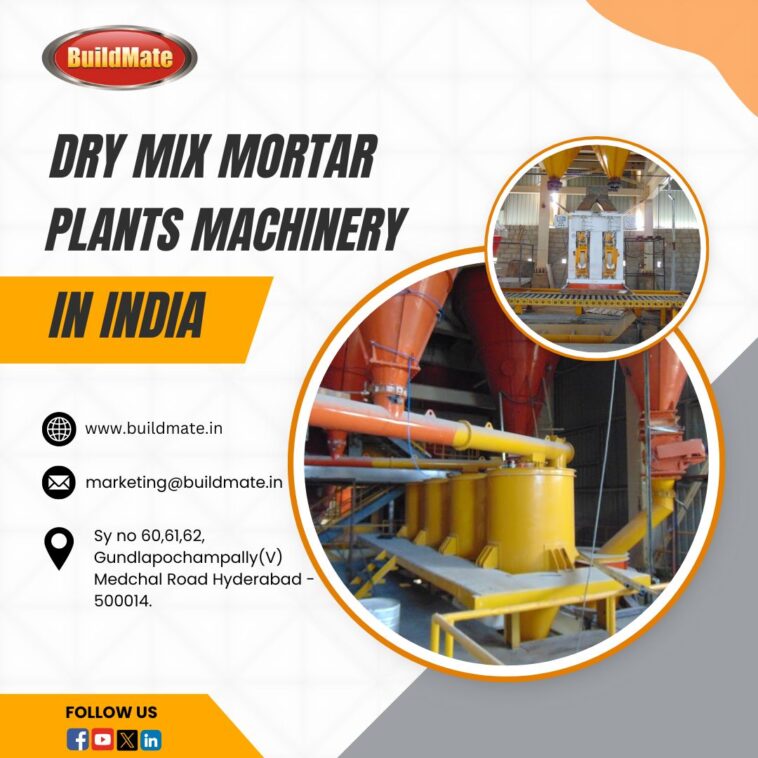Dry mix mortar plants are crucial for creating high-quality mortar used in construction projects. These plants are designed to efficiently mix dry materials to create a consistent and reliable mortar mix. Understanding the working process of dry mix mortar plant machinery is crucial for anyone involved in construction or planning to set up such a plant. This guide explains the key components and steps involved in the operation of dry mix mortar plant machinery.
Introduction to Dry Mix Mortar Plants
Dry mix mortar plants are industrial facilities that manufacture dry mix mortar. Unlike traditional mortar, which is mixed with water on-site, dry mix mortar manufacturers are prepared in the plant and transported to the construction site. This method provides several benefits, such as enhanced consistency, lower labor costs, and superior quality control.
Key Components of Dry Mix Mortar Plants
To understand the working process, it’s important to first familiarize yourself with the main components of a dry mix mortar plant:
a. Raw Material Storage: The plant begins with the storage of raw materials. Common raw materials include cement, sand, and additives. These materials are stored in silos or bins to ensure they are kept dry and free from contamination.
b. Weighing System: Accurate measurement of materials is crucial for producing a consistent mortar mix. The weighing system includes digital scales and load cells that measure the precise quantity of each raw material required for the mix.
c. Mixing System: The mixing system is the heart of the dry mix mortar machine. It combines the raw materials in the correct proportions. Common types of mixers used include twin-shaft mixers and vertical mixers. The choice of mixer depends on the plant’s production capacity and the type of mortar being produced.
d. Pneumatic Conveying System: Once the raw materials are mixed, they need to be transported to the packaging or storage area. The pneumatic conveying system uses air pressure to move the mixed mortar through pipelines, ensuring smooth and efficient transfer.
e. Packaging System: The final step in the process is packaging the dry mortar mixing equipment. This can be done using manual or automated packaging systems. Automated systems use machines to fill bags or containers with the finished mortar, seal them, and label them for distribution.
f. Control System: Modern dry mix mortar plants are equipped with advanced control systems. These systems allow operators to monitor and control various aspects of the plant’s operation, including material flow, mixing time, and production rates. They help ensure that the plant operates efficiently and that the final product meets quality standards.
3. The Working Process
a. Material Loading: The process begins with loading raw materials into the dry plant. Materials such as cement, sand, and additives are transported from storage silos or bins to the weighing system. The quantities are accurately measured according to the specific formulation for the mortar mix.
b. Weighing and Proportioning: Once the raw materials are loaded into the weighing system, they are weighed and proportioned according to the recipe. This step is critical for ensuring that the mortar mix has the correct properties and performance characteristics.
c. Mixing: After the materials are weighed, they are transferred to the mixing system. The mixer combines the raw materials thoroughly to create a consistent mixture. The mixing time and speed are carefully controlled to achieve the desired consistency and quality of the mortar.
d. Pneumatic Conveying: Once the mixing is complete, the mixed mortar plant is transported to the packaging or storage area using the pneumatic conveying system. This system moves the mortar through pipelines, minimizing handling and reducing the risk of contamination.
e. Packaging: The last step in the process is packaging the dry mix mortar. The packaging system fills bags or containers with the finished mortar, seals them, and labels them. This ensures that the product is ready for distribution and use at construction sites.
f. Quality Control: Throughout the process, quality control measures are in place to ensure that the mortar meets industry standards. Samples of the mixed mortar are tested for properties such as strength, consistency, and workability. Any deviations from the specifications are addressed to maintain the quality of the final product.
Advantages of Dry Mix Mortar Plants
Dry mix mortar plants suppliers offer several benefits compared to traditional mortar mixing methods:
a. Consistency: Dry mix mortar plants produce a consistent product every time. The precise measurement and mixing of raw materials ensure that the mortar has uniform properties, leading to better performance and durability.
b. Efficiency: The automation and efficiency of dry mortar plants reduce labor costs and cut down production time. The use of advanced machinery and control systems streamlines the process and increases overall productivity.
c. Quality Control: With stringent quality control measures in place, mix mortar plants can produce high-quality mortar that meets industry standards. This leads to a product that is both more reliable and durable.
d. Reduced Waste: Dry mix mortar machines minimize waste by accurately measuring and mixing materials. This not only reduces material costs but also decreases the environmental impact of construction projects.
Conclusion
Buildmate’s dry mix mortar plants machinery in India offers a reliable and efficient solution for construction needs. Their advanced technology and dependable systems ensure high-quality production of dry mix mortar. The equipment provided enhances consistency and performance, making it ideal for various construction projects. Opting for this brand means choosing superior machinery that supports effective and cost-efficient mortar production.
This post was created with our nice and easy submission form. Create your post!





